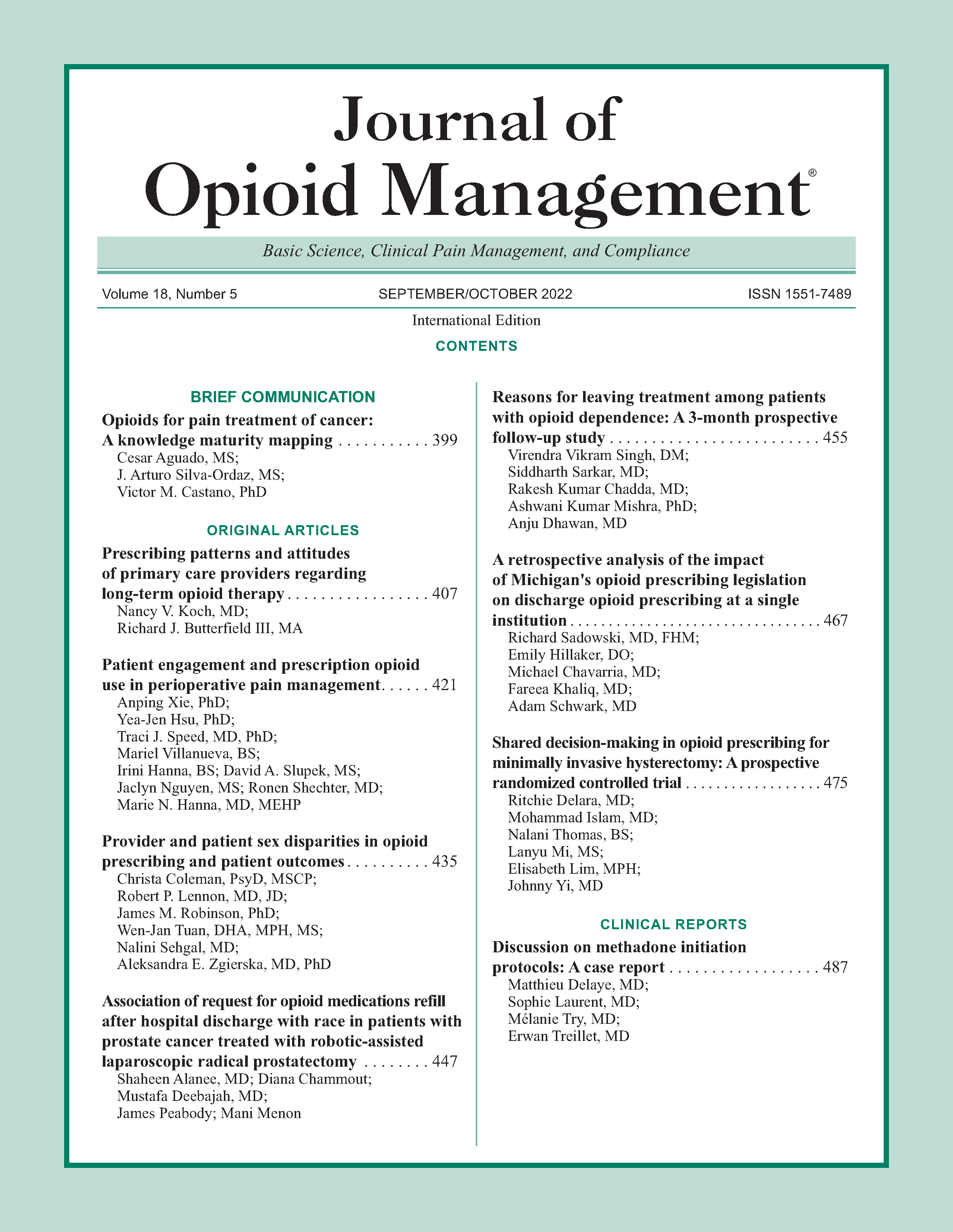Association of request for opioid medications refill after hospital discharge with race in patients with prostate cancer treated with robotic-assisted laparoscopic radical prostatectomy
DOI:
https://doi.org/10.5055/jom.2022.0738Keywords:
opioids, request for refill, race, prostate cancer, prostatectomyAbstract
Background and objective: Request for refills of opioids is one of the indicators of possible misuse. We aimed to investigate racial variations in request for refills of opioids after hospital discharge from robotic-assisted laparoscopic radical prostatectomy (RALP).
Methods: We conducted a retrospective study of a contemporary cohort of patients treated with RALP for prostate cancer and post-operative standardized pain control that employed nonopioid medications. Patients’ request for refills of opioids (within 30 days) after discharge was examined, accounting for race, age, pain control after surgery, alcohol intake, marijuana consumption, pre-existing behavioral health diagnoses, and pre-existing chronic pain disorders using multivariate analysis. p-Value of < 0.05 was considered significant.
Results: We included a total of 282 adult patients in this study. African Americans (AA) patients comprised 24.5 percent of our post-prostatectomy individuals. Of the total cohort, 94.3 percent of patients reported adequate pain control in the hospital after surgery, and only 5.7 percent requested refills of opioid medications after discharge. No racial variations in request of refills were identified. Only pre-existing chronic pain disorders were found to be a significant predictor of requesting an opioid medication refill for pain control after discharge from the hospital.
Conclusions: A combination of minimally invasive surgery and nonopioid heavy pain management leads to low level of post-hospital discharge request for refills of opioid medication in patients treated with RALP across racial groups. Awareness and better control of chronic pain perioperatively are needed to ensure better post-discharge pain control.
References
Hedegaard H, Warner M, Minino AM: Drug overdose deaths in the United States, 1999-2015. NCHS Data Brief. 2017; 273: 1-8.
Brummett CM, Waljee JF, Goesling J, et al.: New persistent opioid use after minor and major surgical procedures in US adults. JAMA Surg. 2017; 152(6): e170504.
Theisen KM, Davies BJ: A radical proposition: Opioid-sparing prostatectomy. Eur Urol Focus. 2020; 6(2): 215-217.
Theisen KM, Myrga JM, Hale N, et al.: Excessive opioid prescribing after major urologic procedures. Urology. 2019; 123: 101-107.
Thiele RH, Sarosiek BM, Modesitt SC, et al.: Development and impact of an institutional enhanced recovery program on opioid use, length of stay, and hospital costs within an academic medical center: A cohort analysis of 7774 patients. Anesth Analg. 2021; 132(2): 442-455.
Shah AS, Blackwell RH, Kuo PC, et al.: Rates and risk factors for opioid dependence and overdose after urological surgery. J Urol. 2017; 198(5): 1130-1136.
Furr-Holden D, Milam AJ, Wang L, et al.: African Americans now outpace whites in opioid-involved overdose deaths: A comparison of temporal trends from 1999 to 2018. Addiction. 2021; 116(3): 677-683.
Ene KW, Nordberg G, Sjostrom B, et al.: Prediction of postoperative pain after radical prostatectomy. BMC Nurs. 2008; 7: 14.
Haider MR, Brown MJ, Gupta RD, et al.: Psycho-social correlates of opioid use disorder among the US adult population: Evidence from the national survey on drug use and health, 2015-2018. Subst Use Misuse. 2020; 55(12): 2002-2010.
Jensen MP, Karoly P, Braver S: The measurement of clinical pain intensity: A comparison of six methods. Pain. 1986; 27(1): 117-126.
Katz N, Panas L, Kim M, et al.: Usefulness of prescription monitoring programs for surveillance—Analysis of schedule II opioid prescription data in Massachusetts, 1996-2006. Pharmacoepidem Drug Safe. 2010; 19(2): 115-123.
Woldu SL, Weinberg AC, Bergman A, et al.: Pain and analgesic use after robot-assisted radical prostatectomy. J Endourol. 2014; 28(5): 544-548.
Pilecki MA, McGuire BB, Jain U, et al.: National multi-institutional comparison of 30-day postoperative complication and readmission rates between open retro-pubic radical prostatectomy and robot-assisted laparoscopic prostatectomy using NSQIP. J Endourol. 2014; 28(4): 430-436.
Ziegelmann MJ, Joseph JP, Glasgow AE, et al.: Wide variation in opioid prescribing after urological surgery in tertiary care centers. Mayo Clin Proc. 2019; 94(2): 262-274.
Perry M, Sieberg CB, Young EE, et al.: The potential role of preoperative pain, catastrophizing, and differential gene expression on pain outcomes after pediatric spinal fusion. Pain Manag Nurs. 2021; 22(1): 44-49.
Patel HD, Faisal FA, Patel ND, et al.: Effect of a prospective opioid reduction intervention on opioid prescribing and use after radical prostatectomy: Results of the opioid reduction intervention for open, laparoscopic, and endoscopic surgery (ORIOLES) initiative. BJU Int. 2020; 125(3): 426-432.
Buys MJ, Bayless K, Romesser J, et al.: Opioid use among veterans undergoing major joint surgery managed by a multidisciplinary transitional pain service. Reg Anesth Pain Med. 2020; 45(11): 847-852.
Published
How to Cite
Issue
Section
License
Copyright 2005-2025, Weston Medical Publishing, LLC and Journal of Opioid Management. All Rights Reserved.











